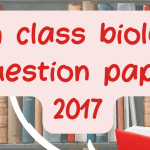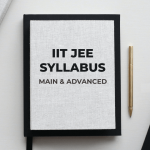The 8th class biology exam covers important topics like cell structure, plant and animal systems, and more. This guide provides common questions and answers to help students understand and prepare for the exam effectively.
Most Asked 8 Class biology Question Paper 2017 and Answers
Cell Structure and Function
Question: What is a cell?
Answer: A cell is the basic structural and functional unit of life.
Question: What are the two main types of cells?
Answer: The two main types of cells are prokaryotic and eukaryotic.
Question: What is the function of the nucleus in a cell?
Answer: The nucleus controls the activities of the cell and contains genetic material.
Question: What is the cytoplasm?
Answer: The cytoplasm is the jelly-like substance inside the cell where organelles are suspended.
Question: What are mitochondria?
Answer: Mitochondria are the powerhouses of the cell, responsible for energy production.
Question: What is the function of the cell membrane?
Answer: The cell membrane controls the movement of substances in and out of the cell.
Question: What is the role of ribosomes in the cell?
Answer: Ribosomes are responsible for protein synthesis in the cell.
Question: What is the difference between plant and animal cells?
Answer: Plant cells have a cell wall and chloroplasts, while animal cells do not.
Question: What is the cell wall made of?
Answer: The cell wall in plant cells is made of cellulose.
Question: What are vacuoles and their function?
Answer: Vacuoles are storage organelles in the cell, mainly for water and nutrients.
Question: What is the function of chloroplasts in plant cells?
Answer: Chloroplasts are responsible for photosynthesis, converting sunlight into energy.
Question: What is the Endoplasmic Reticulum (ER)?
Answer: The ER is a network of membranes involved in protein and lipid synthesis.
Question: What is a lysosome?
Answer: Lysosomes contain digestive enzymes that break down waste materials and cellular debris.
Question: What is the Golgi apparatus?
Answer: The Golgi apparatus modifies, sorts, and packages proteins for secretion.
Question: What is the function of centrioles?
Answer: Centrioles are involved in cell division in animal cells.
Question: How does the cell maintain homeostasis?
Answer: Cells maintain homeostasis by regulating the balance of materials through the cell membrane.
Question: What is DNA?
Answer: DNA is the molecule that carries genetic information in cells.
Question: What is osmosis?
Answer: Osmosis is the movement of water across a semipermeable membrane from a region of lower concentration to higher concentration.
Question: What are stem cells?
Answer: Stem cells are undifferentiated cells that have the potential to become various types of cells.
Question: What are chromosomes?
Answer: Chromosomes are thread-like structures made of DNA and proteins that carry genetic information.
Human Body Systems
Question: What is the function of the respiratory system?
Answer: The respiratory system exchanges oxygen and carbon dioxide between the body and the environment.
Question: How do the lungs work in the respiratory system?
Answer: The lungs take in oxygen during inhalation and release carbon dioxide during exhalation.
Question: What is the circulatory system responsible for?
Answer: The circulatory system transports blood, nutrients, and oxygen throughout the body.
Question: What is the heart’s function in the circulatory system?
Answer: The heart pumps blood through the blood vessels to all parts of the body.
Question: What is the digestive system’s role?
Answer: The digestive system breaks down food into nutrients that can be absorbed and used by the body.
Question: What organs are involved in the digestive system?
Answer: The digestive system includes the mouth, esophagus, stomach, intestines, and liver.
Question: What is the function of the skeletal system?
Answer: The skeletal system provides structure, support, and protection for the body and its organs.
Question: What are the major bones in the human body?
Answer: Major bones include the skull, spine, ribs, and limbs.
Question: What is the muscular system responsible for?
Answer: The muscular system is responsible for movement and maintaining posture.
Question: How do muscles work with bones?
Answer: Muscles contract and pull on bones to produce movement.
Question: What is the nervous system’s role?
Answer: The nervous system controls and coordinates the body’s activities by transmitting signals between different body parts.
Question: What are neurons?
Answer: Neurons are the basic units of the nervous system, transmitting signals throughout the body.
Question: What is the endocrine system?
Answer: The endocrine system is a collection of glands that secrete hormones to regulate body functions.
Question: What is the immune system?
Answer: The immune system defends the body against infections and diseases.
Question: How does the body maintain homeostasis?
Answer: The body maintains homeostasis through feedback mechanisms that balance internal conditions, like temperature and pH levels.
Question: What is the role of the kidneys in the excretory system?
Answer: The kidneys filter waste products from the blood and produce urine.
Question: What is the function of the liver?
Answer: The liver detoxifies harmful substances and produces bile for digestion.
Question: What are hormones?
Answer: Hormones are chemical messengers that regulate various functions in the body.
Question: How does the brain control the body?
Answer: The brain processes information and sends signals through the nervous system to control body functions.
Question: What is the function of the reproductive system?
Answer: The reproductive system is responsible for producing offspring and ensuring the continuation of the species.
Plants and Photosynthesis
Question: What is photosynthesis?
Answer: Photosynthesis is the process by which plants use sunlight, carbon dioxide, and water to produce glucose and oxygen.
Question: Where does photosynthesis occur in plants?
Answer: Photosynthesis occurs in the chloroplasts of plant cells.
Question: What is chlorophyll?
Answer: Chlorophyll is the green pigment in plants that absorbs light for photosynthesis.
Question: What are the products of photosynthesis?
Answer: The products of photosynthesis are glucose (sugar) and oxygen.
Question: What is the role of stomata in plants?
Answer: Stomata are tiny openings in leaves that allow gas exchange during photosynthesis.
Question: How do plants absorb water?
Answer: Plants absorb water through their roots, which is then transported to other parts of the plant.
Question: What is the function of xylem and phloem in plants?
Answer: Xylem transports water and nutrients, while phloem transports sugars produced during photosynthesis.
Question: What is the role of roots in plants?
Answer: Roots anchor the plant in the soil and absorb water and nutrients.
Question: How do plants reproduce?
Answer: Plants reproduce through seeds, spores, or vegetative parts like stems and roots.
Question: What is pollination?
Answer: Pollination is the transfer of pollen from the male part of a flower to the female part for fertilization.
Question: What is the function of a flower?
Answer: The flower is the reproductive part of a plant, responsible for producing seeds.
Question: What is a seed?
Answer: A seed is a small structure that contains a plant embryo and can grow into a new plant.
Question: What are the parts of a leaf?
Answer: The main parts of a leaf are the blade, petiole, and veins.
Question: How do plants respond to their environment?
Answer: Plants respond to their environment through tropisms, such as growing towards light (phototropism) or responding to gravity (gravitropism).
Question: What is transpiration in plants?
Answer: Transpiration is the process by which water evaporates from the leaves of plants, helping to cool the plant and draw up water.
Question: What are the different types of plant tissues?
Answer: The main types of plant tissues are dermal, vascular, and ground tissues.
Question: How do plants adapt to different environments?
Answer: Plants adapt through changes in structure, like developing thicker leaves or deep roots to survive in harsh conditions.
Question: What is germination?
Answer: Germination is the process by which a seed develops into a new plant.
Question: What are the stages of plant growth?
Answer: The stages of plant growth include germination, seedling development, vegetative growth, and flowering.
Question: How do plants produce oxygen?
Answer: Plants produce oxygen as a byproduct of photosynthesis during the conversion of carbon dioxide and water into glucose.
Question: What are gymnosperms and angiosperms?
Answer: Gymnosperms are plants that produce seeds without flowers, while angiosperms produce seeds within flowers.
Latest Posts
- Step-by-step guide to download and apply for jee mains admit card 202
- Comprehensive 2025 government holidays and recruitment details for job seekers
- JEE Mains Admit Card 2025: Your Step-by-Step Guide to Downloading the Hall Ticket
- Everything You Need to Know About 2025 Government Holidays Recruitment
- Comprehensive Guide to rrb d group recruitment 2025 – Eligibility, Vacancies, and Application
- Detailed guide to nps trust recruitment 2025 vacancies, eligibility and apply process
- Comprehensive guide to hpcl recruitment 2025 notification, vacancies, and application process
- ignou bed admission 2025 complete recruitment guide with eligibility and process
- Comprehensive Guide to Indian Army Agniveer Recruitment 2025 Notification and Jobs
- Everything You Must Know About CBSE Board Exams 2025 Changes & New Rules






